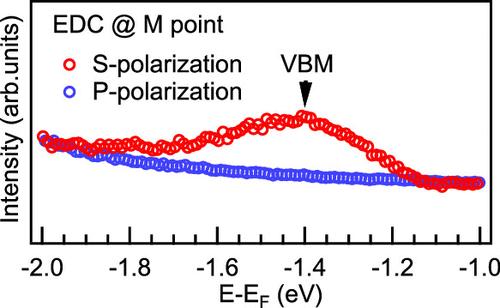TlInSe2 电子结构的温度依赖性和自旋轨道耦合
IF 4.3
3区 材料科学
Q1 ENGINEERING, ELECTRICAL & ELECTRONIC
引用次数: 0
摘要
利用高分辨率角度分辨光发射光谱 (ARPES) 研究了半导体 TlInSe2 在 185 K 和 135 K 时的电子结构相变。在 300、160 和 30 K 时,沿布里渊区 (BZ) 的 X-M、X-N′ 和 X/Γ-P/Z 方向的 ARPES 强度图显示,价带最大值 (VBM) 位于 BZ 的 M 点和 Z 点,因此 Z 点的结合能比 M 点高 65 ± 10 meV。在 TlInSe2 中观察到了强烈的偏振效应,抑制了光的水平偏振(P-pol)时 M 点的 VBM 强度。在高对称点处观察到价带(VBs)有相当大的自旋轨道(SO)分裂,其绝对能量与基于密度泛函理论的 X、N′ 和 M 点理论数据十分吻合。基于 ARPES 观察到的极化效应和 VB 的 SO 分裂以前从未报道过。在不同温度下测量的实验带状结构数据显示,在冷却过程中,VB 之间会出现带状分裂,费米没有移动。ARPES 结果支持三维电子结构,而不是准一维行为。本文章由计算机程序翻译,如有差异,请以英文原文为准。

Temperature Dependence of the Electronic Structure of TlInSe2 and Spin–Orbit Coupling
Using high-resolution angle-resolved photoemission spectroscopy (ARPES), the electronic structure of the semiconductor TlInSe2 is investigated across the reported structural phase transitions at 185 and 135 K. The ARPES intensity maps along the X-M, X-N′, and X/Γ-P/Z directions of the Brillouin zone (BZ) at 300, 160, and 30 K reveal that the valence band maxima (VBM) are located at the M and Z points of the BZ, such that at the Z point it has about 65 ± 10 meV higher binding energy than at the M point. A strong polarization effect is observed in TlInSe2, suppressing the intensity at the VBM at the M point for horizontal polarization (P-pol) of light. A sizable spin–orbit (SO) splitting of the valence bands (VBs) is observed at the high symmetry points with absolute energies in good agreement with theoretical data based on density functional theory at the X, N′, and M points. The observed polarization effect and the SO splitting of the VBs based on ARPES have not been reported before. The experimental band structure data measured at different temperatures reveal that upon cooling, a band splitting develops between VBs, with no shift of the Fermi. The ARPES results support a three-dimensional electronic structure instead of quasi-one-dimensional behavior.
求助全文
通过发布文献求助,成功后即可免费获取论文全文。
去求助
来源期刊

ACS Applied Electronic Materials
Multiple-
CiteScore
7.20
自引率
4.30%
发文量
567
期刊介绍:
ACS Applied Electronic Materials is an interdisciplinary journal publishing original research covering all aspects of electronic materials. The journal is devoted to reports of new and original experimental and theoretical research of an applied nature that integrate knowledge in the areas of materials science, engineering, optics, physics, and chemistry into important applications of electronic materials. Sample research topics that span the journal's scope are inorganic, organic, ionic and polymeric materials with properties that include conducting, semiconducting, superconducting, insulating, dielectric, magnetic, optoelectronic, piezoelectric, ferroelectric and thermoelectric.
Indexed/Abstracted:
Web of Science SCIE
Scopus
CAS
INSPEC
Portico
 求助内容:
求助内容: 应助结果提醒方式:
应助结果提醒方式:


